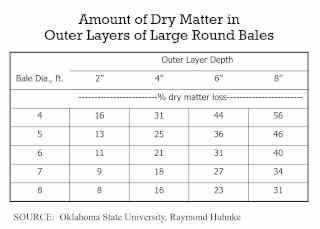
Research from past studies shows outdoor storage losses range from 5-35%, this can be reduced by 2/3 with indoor storage and be reduced by 50% with good plastic covering outdoors. Recommendations for Storage Techniques. Make a dense bale: It will shed more precipitation, sag less, and have less surface area to absorb moisture. By using net wrap, you will reduce bale sag and maintain bale shape. In addition, net wrap makes a tight, smooth surface that will resist weathering, insects, and rodents. Store bales on a well-drained location with a 4–6-inch coarse rock base that will minimize bottom spoilage. Store bales end-to-end, in rows, facing in a northwest to southeastern direction whenever possible. Space adjacent lines at least 10 feet apart. Stacking bales usually increase losses. Locate bale rows away from fences and fields and it is recommended to cover hay if keeping more than one year.
Source : unl.edu